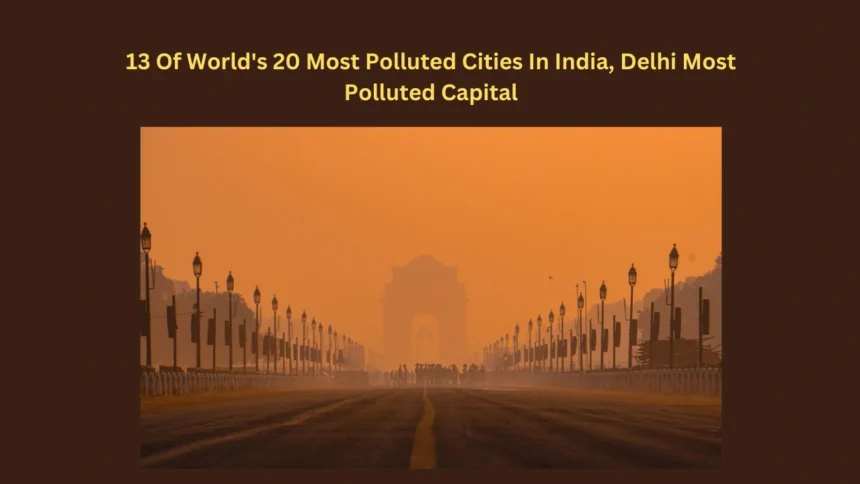IQAir has released its 7th annual World Air Quality Report, offering a stark analysis of global air pollution trends in 2024. The report, based on data from 40,000+ air quality monitoring stations across 138 countries, territories, and regions, highlights the worsening air pollution crisis, particularly in India, which continues to dominate the list of the world’s most polluted cities.
India: The World’s Pollution Hotspot
- 13 of the world’s top 20 most polluted cities are in India.
- Byrnihat, Assam, has been ranked the most polluted city globally, with an annual average PM2.5 concentration of 128.2 µg/m³.
- Delhi remains the world’s most polluted capital city, with an annual PM2.5 average of 91.6 µg/m³—nearly unchanged from 92.7 µg/m³ in 2023.
- Six of the world’s top 10 most polluted cities are in India.
Key Findings from the 2024 Report
India’s Overall Pollution Trends
- India ranked as the 5th most polluted country in 2024 (down from 3rd in 2023).
- PM2.5 concentrations in India declined by 7%, averaging 50.6 µg/m³ in 2024 compared to 54.4 µg/m³ in 2023.
- 35% of Indian cities reported PM2.5 levels exceeding 10 times the WHO’s safe limit of 5 µg/m³.
Most Polluted Cities in India (Top 13 in the World’s Top 20)
1️⃣ Byrnihat, Assam
2️⃣ Delhi
3️⃣ Mullanpur, Punjab
4️⃣ Faridabad, Haryana
5️⃣ Loni, Uttar Pradesh
6️⃣ New Delhi
7️⃣ Gurugram, Haryana
8️⃣ Ganganagar, Rajasthan
9️⃣ Greater Noida, Uttar Pradesh
🔟 Bhiwadi, Rajasthan
1️⃣1️⃣ Muzaffarnagar, Uttar Pradesh
1️⃣2️⃣ Hanumangarh, Rajasthan
1️⃣3️⃣ Noida, Uttar Pradesh
Health Risks and Life Expectancy Decline
Air pollution remains a severe public health crisis in India, contributing to millions of deaths and reducing life expectancy.
Health Impact of Air Pollution in India:
- PM2.5 exposure reduces life expectancy by an estimated 5.2 years.
- 1.5 million deaths per year in India (2009–2019) were linked to long-term exposure to PM2.5 pollution (Lancet Planetary Health, 2023).
- PM2.5 particles penetrate deep into the lungs and bloodstream, leading to respiratory diseases, heart conditions, and cancer.
- Major sources include vehicle emissions, industrial pollution, and crop-burning practices.
Urgent Call for Policy Interventions and Cleaner Air Solutions
While India has shown a slight decline in PM2.5 levels, pollution remains alarmingly high, requiring immediate policy actions and technological solutions to improve air quality.
Proposed Measures to Combat Air Pollution:
- Stricter vehicle emission norms and electrification of public transport.
- Strengthening air quality monitoring systems across all states.
- Reducing reliance on fossil fuels and promoting renewable energy solutions.
- Scaling up afforestation efforts and expanding urban green spaces.
- Community-driven initiatives to curb crop-burning and industrial emissions.
A Global Issue: Urgent Need for Collaborative Action
IQAir’s report underscores the need for global cooperation to address air pollution and climate change. Low-cost air quality monitors, driven by citizen scientists, researchers, and local communities, have emerged as powerful tools in filling data gaps, providing real-time pollution insights, and guiding policy interventions.
“Air pollution remains a critical threat to both human health and environmental stability, yet vast populations remain unaware of their exposure levels,” said Frank Hammes, Global CEO of IQAir. “Real-time air quality data empowers communities, informs policies, and saves lives.”
Conclusion: A Race Against Time
The World Air Quality Report 2024 serves as a call to action for governments, corporations, and individuals to implement bold solutions for cleaner air. As air pollution continues to threaten millions of lives, decisive steps are needed to reduce emissions, enhance monitoring, and enforce stringent environmental policies.














